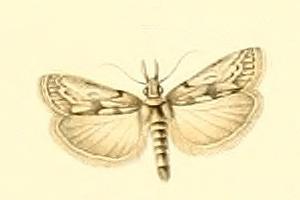
Dioryctria sylvestrella, the new pine knot-horn or maritime pine borer, is a moth of the family Pyralidae. It is found in Europe, parts of Asia and North Africa. The adult is a small mottled brown and white insect with a wingspan of 28 to 35 mm. The moth flies in a single generation from June to October and is a pest of maritime pine and several other species of pine, on which the caterpillars feed.

The Phycitinae are a subfamily of snout moths. Even though the Pyralidae subfamilies are all quite diverse, Phycitinae stand out even by standards of their family: with over 600 genera considered valid and more than 4000 species placed here at present, they unite up more than three-quarters of living snout moth diversity. Together with the closely related Epipaschiinae, they are apparently the most advanced lineage of snout moths.

Dioryctria auranticella, the ponderosa pineconeworm moth, is a moth of the family Pyralidae. The species was first described by Augustus Radcliffe Grote in 1883. It is found in western North America from southern British Columbia south to California and Arizona, east to South Dakota and New Mexico.

Dioryctria ponderosae, the ponderosa twig moth, is a moth of the family Pyralidae. The species was first described by Harrison Gray Dyar Jr. in 1914. It is found in North America from Washington and Montana south to California and northern Mexico.

Dioryctria banksiella is a species of snout moth in the genus Dioryctria. It was described by Akira Mutuura, Eugene G. Munroe and Douglas Alexander Ross in 1969, and it is found in Canada from Alberta and the Northwest Territories eastward.
Dioryctria batesella is a species of snout moth belonging to the genus of Dioryctria. It was described by Akira Mutuura and Herbert H. Neunzig in 1986 and is known from Guatemala, Nicaragua and Honduras.
Dioryctria cibriani is a species of snout moth in the genus Dioryctria. It was described by Akira Mutuura and Herbert H. Neunzig in 1986 and is known from Mexico.
Dioryctria durangoensis is a species of snout moth in the genus Dioryctria. It was described by Akira Mutuura and Herbert H. Neunzig in 1986 and was described from Durango, Mexico, from which its species epithet is derived.
Dioryctria erythropasa is a species of snout moth in the genus Dioryctria. It was described by Harrison Gray Dyar Jr. in 1914 and is found from Arizona south along the Mexican Pacific coast to Central America.
Dioryctria raoi is a species of snout moth in the genus Dioryctria. It was described by Akira Mutuura in 1971 and is known from northern India.
Dioryctria pinicolella is a species of snout moth in the genus Dioryctria. It was described by Hans Georg Amsel in 1962 and is known from Central America, including Mexico and Guatemala.
Dioryctria rossi is a species of snout moth in the genus Dioryctria. This moth was discovered and named by Douglas Alexander Ross, chief entomologist at the Vernon forest entomology laboratory and research centre in Vernon, British Columbia, from 1950 to 1970. It was described by Eugene G. Munroe in 1959. It is found in western North America, from southern British Columbia to northern Mexico and east to New Mexico.
Dioryctria fordi is a species of snout moth in the genus Dioryctria. It was described by Julian P. Donahue and Herbert H. Neunzig in 2002 and is known from the US state of California.
Dioryctria magnifica is a species of snout moth in the genus Dioryctria. It was described by Eugene G. Munroe in 1958 and is known from China.

Dioryctria okanaganella is a species of snout moth in the genus Dioryctria. It was described by Akira Mutuura, Eugene G. Munroe and Douglas Alexander Ross in 1969. It is found in western North America from southern British Columbia to northern California.
Dioryctria okui is a species of snout moth in the genus Dioryctria. It was described by Akira Mutuura in 1958 and is known from Japan.

Dioryctria robiniella is a species of snout moth in the genus Dioryctria. It was described by Pierre Millière in 1865, and is known from France, Spain, Croatia and Italy.
Dioryctria tumicolella is a species of snout moth in the genus Dioryctria. It was described by Akira Mutuura, Eugene G. Munroe and Douglas Alexander Ross in 1969, and is known from British Columbia, Canada, but is possibly present in all of north-western North America.
Dioryctria vancouverella is a species of snout moth in the genus Dioryctria. It was described by Akira Mutuura, Eugene G. Munroe and Douglas Alexander Ross in 1969, and is known from southern British Columbia, Canada. It is named for the city of Vancouver, from which the type specimen was collected.
Dioryctria yatesi, the mountain pine coneworm, is a species of snout moth in the genus Dioryctria. It was described by Akira Mutuura and Eugene G. Munroe in 1979 and is limited to the mountains of the coastal south-eastern United States and Tennessee.





